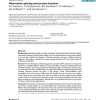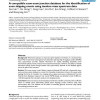132
click to vote
NAR
2010
14 years 7 months ago
2010
Alternative splicing is an important mechanism for increasing protein diversity. However, its functional effects are largely unknown. Here, we present our new software workflow co...
123
click to vote
NAR
2000
15 years 17 days ago
2000
Version 2.1 of ASDB (Alternative Splicing Data Base) contains 1922 protein and 2486 DNA sequences. The protein entries from SWISS-PROT are joined into clusters corresponding to al...
124
click to vote
BMCBI
2004
15 years 19 days ago
2004
Background: Alternative splicing is an efficient mechanism for increasing the variety of functions fulfilled by proteins in a living cell. It has been previously demonstrated that...
127
click to vote
BMCBI
2004
15 years 19 days ago
2004
Background: A wealth of quality genomic and mRNA/EST sequences in recent years has provided the data required for large-scale genome-wide analysis of alternative splicing. We have...
112
click to vote
BMCBI
2005
15 years 20 days ago
2005
Background: Alternative splicing is a major mechanism of generating protein diversity in higher eukaryotes. Although at least half, and probably more, of mammalian genes are alter...
NAR
2006
15 years 22 days ago
2006
Alternative splicing is an important regulatory mechanism of mammalian gene expression. The alternative splicing database (ASD) consortium is systematically collecting and annotat...
104
click to vote
CORR
2007
Springer
15 years 23 days ago
2007
Springer
Questions of understanding and quantifying the representation and amount of information in organisms have become a central part of biological research, as they potentially hold th...
172
click to vote
BMCBI
2008
15 years 27 days ago
2008
Background: Alternative splicing is an important gene regulation mechanism. It is estimated that about 74% of multi-exon human genes have alternative splicing. High throughput tan...
131
click to vote
BMCBI
2008
15 years 27 days ago
2008
Background: Alternative splicing is a major contributor to the diversity of eukaryotic transcriptomes and proteomes. Currently, large scale detection of alternative splicing using...
107
click to vote
BMCBI
2008
15 years 27 days ago
2008
Background: Previous studies comparing quantitative proteomics and microarray data have generally found poor correspondence between the two. We hypothesised that this might in par...


